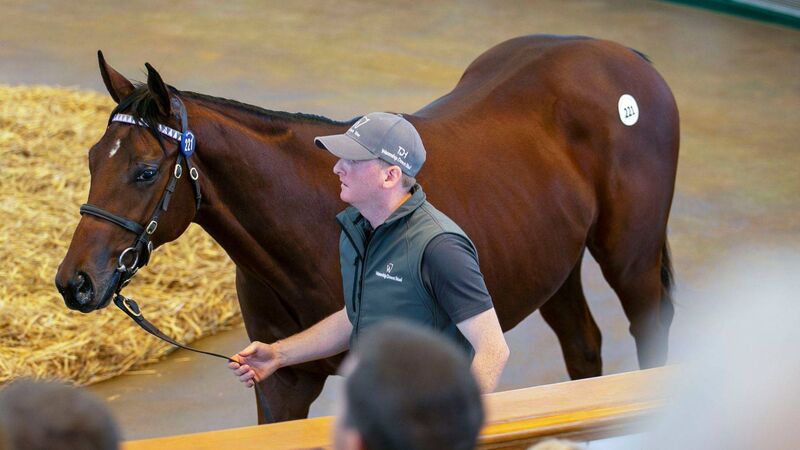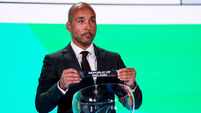Ruby Walsh: The microbubble of horse racing continues to defy most logic

LOT 221: The record-breaking son of Frankel in the sales ring at Tattersalls in Newmarket on Wednesday.
The seasonal crossover between Flat and National Hunt is in full swing as we await the winter stars to emerge while the summer heroes and heroines wind down, and consequently, it is hard to get super excited about the action on the track this weekend.
Billy Lee and Colin Keane are making the end of the Irish Flat season enjoyable as they battle away to be crowned champion jockey. Seventeen scheduled meetings remain between now and Naas on November 6 and, at a score of 80-79 in Billy's favour before Dundalk on Friday night, it is pretty much evens your pick. It is hard to shout for one over the other as neither do anything but impress you every time you meet them.
The Dewhurst and Cesarewitch are the primary races in the UK, and dry ground could see the real Aesop’s Fable turn up at Newmarket. I like what I have seen from Scaramanga at home since he arrived in Willie Mullins's yard, from Paul Nicholls, and he has an each-way chance in the valuable staying handicap.
However, whatever happens on the Rowley Mile will do well to rival the excitement at Park Paddocks, where the Tattersalls sales ring in Newmarket was a hive of activity all week as those at the top end of the sport restocked their yards for next season's action.
A total of 549 lots were catalogued for sale over the week, and Lot 3 on Tuesday set the tone by making £1.3m (€1.4m). However, by close of play on Thursday, he didn't even make the top 10 lots sold.
Twice on Wednesday the bids soared over £2m (€2.2m) as purchasers battled to acquire what they believed could be the next champion racehorse at the Book One Yearling Sales. Richard Knight bloodstock went there on the final day, but the most expensive four horses sold all had one thing in common: Frankel was their daddy.
Maybe he will produce offspring to rival his achievements on the track, but it's the second career where their earning power lies. The most expensive one cost £2.8m (€3.1m), which is only slightly less than Frankel earned in a glorious career on the track: He won all 14 races he contested, including 10 Group 1s, to reach £2.9m (€3.3m).
The combined total of £9.2m (€10.4m) for the top four Frankel yearlings at Newmarket is only 46 covers for him at stud — just shy of a quarter of his yearly potential earning power at stud. A total of 250 covers should produce 200 live foals, each of which will cost their mother's owner £200,000 (€227,442) and make Frankel’s owner £40m (€45.4m).
Given the current world economic climate I doubt many thought the market would be so strong, but the microbubble of horse racing defies most logic, as does the process of how people invest such large sums of money into unproven assets. They all have potential, but so does every good idea.
They are purchased on spec with the aid of pedigrees, physical inspections, veterinary certificates, and assessment of how they walk, trot and behave in an atmospheric environment. None have ever been sat on or seen to gallop other than loose in a field, so it is a judgement call.
They will have to become good racehorses before any breeder wants to use them at stud, but young stock sales are the investment in a dream of finding the next Frankel, Sea the Star,s or Baaeed. Or even So Mi Dar or Sweepstake, who could be a potential stallion or prolific broodmare.
The purchase prices show you where the real business is in horse racing. Only a tiny percentage of those offered will earn their purchase price in prize money, and a smaller percentage again of the colts will have a stud value.
The upward trend in sales reflects the growth of the sport globally, but the potential return from the sport must be able to help balance some of the investment for those below the powerhouse breeders. The popularity of racing in Britain and Ireland is vital to the health of the business behind the sport, but looking at the value of the stock, perhaps the industry needs to help the sport more.
- Last Friday, any journalist worth his salt would have turned around a piece on Christophe Soumillon’s Saint Cloud antics in time for Saturday's paper. I didn’t even try because my typing skills would never allow that, so eight days later, with much water having flowed under the bridge, I got around to it.
Simply put, he shoved Rossa Ryan off when trying to get out of a pocket mid-way down the back straight. A stupid thing to do but, thankfully, Rossa bounced and rolled away to safety.
The first question I asked myself was, ‘what was he trying to do?’ Did he really mean to knock an opponent off his horse? No, because if he was, why did he use his body weight and risk falling off himself when he could have pushed him with his hand or pulled him off?
So, why or how did it happen? Horse racing is meant to be a non-contact sport, like athletics, basketball and Formula One, but, like all of those, a lot of contact takes place. None of it is supposed to, but in a competitive environment it happens, and when you misjudge it, as Christophe did, you should get a penalty such as the one he got.
Christophe's horse didn't roll with his body weight, and instead of his horse moving Rossa's horse out a bit, Christophe moved Rossa, who wasn't expecting an elbow in the ribs. Nor should he have been, but I don’t believe Christophe ever intended the result, and intent has to factor in the consequences of any action. The France Galop stewards reacted swiftly and handed Christophe a 60-day ban.
In horse racing, that’s 60 days with racing, not just days of the week, and with the ban came the loss of his retainer with the Aga Khan studs. An expensive mistake. Credit must go to Rossa Ryan, who has just gone about his business since last Friday as usual. No drama, tears, or antics, and while one didn't set an example, Rossa certainly did.









